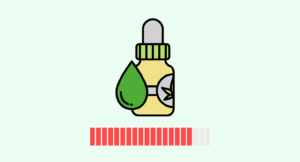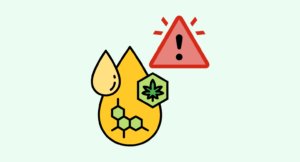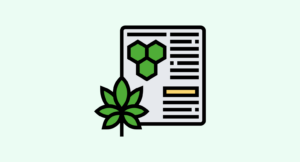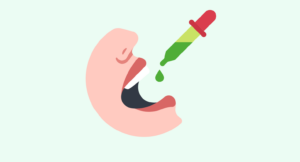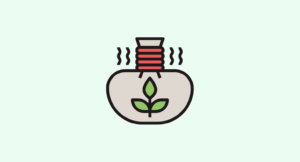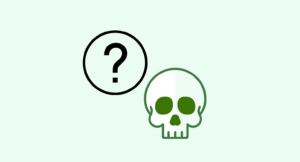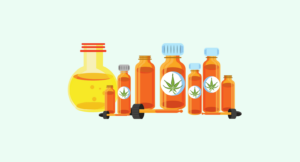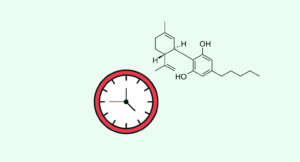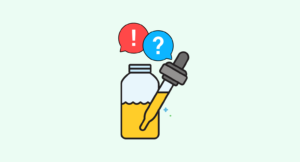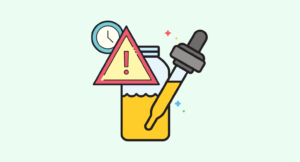
Evidence based
CBD 101: What is Cannabidiol? Does It Really Work?
If you’re brand new to CBD — you’re in the right place.
This in-depth guide covers everything you need to know about the benefits of CBD, how it’s used, what dose to use, and where to buy CBD products where you live.
Cannabidiol (CBD) is one of the active constituents of the cannabis plant.
It’s suggested to offer support for conditions such as epilepsy, insomnia, anxiety, multiple sclerosis, skin conditions, pain, and much more.
How can a single compound have such a profound impact on so many aspects of our health?
Can it really do all of these things?
In this ultimate guide to CBD, we touch on everything you need to know about CBD to start using it safely and effectively. We’ll explore how it works, what the research says, and what claims are inflated or exaggerated.
What is Cannabidiol?
Cannabidiol is just one of over 400 chemicals contained in the cannabis plant [1]. It’s the primary medicinal component in the leaves and flowers.
CBD owes most of its health benefits to its ability to interact with the endocannabinoid system — which is a system made up of receptors and hormones tasked with maintaining balance (homeostasis) throughout the body. We’ll cover this system in more detail later.
There are over 117 different cannabinoids in the cannabis plant — each one with its own pharmacological profile.
The most abundant cannabinoid in the plant is usually CBD, followed by the main psychoactive component — THC (tetrahydrocannabinol). Other cannabinoids like CBC (cannabichromene), CBG (cannabigerol), and CBN (cannabinol) make up the bulk of the remaining cannabinoid profile.
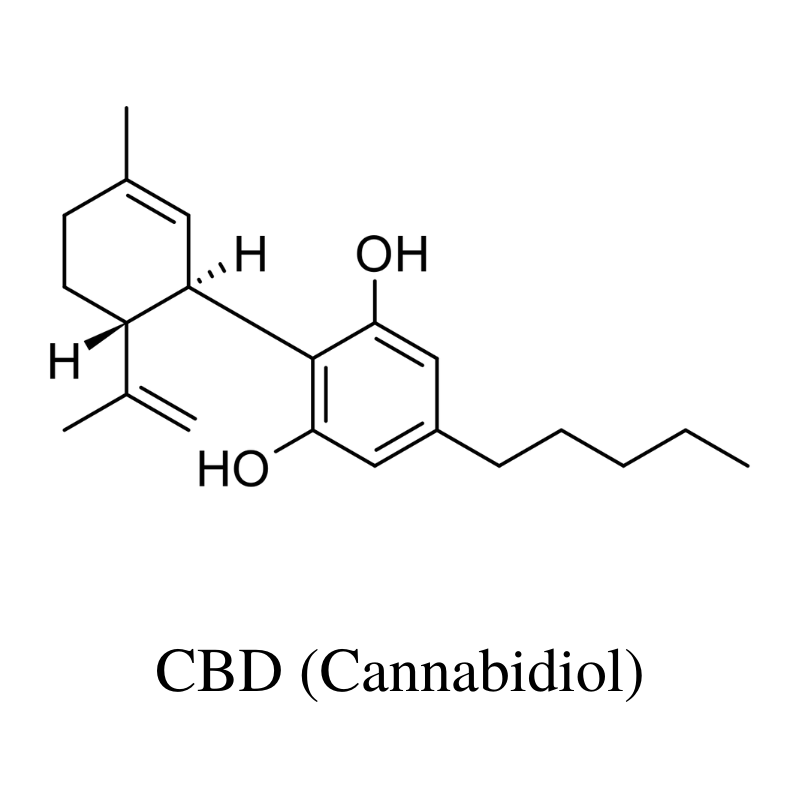
What Are the Benefits of CBD?
CBD has many reported benefits — from easing pain and inflammation all the way to protecting the neurons from degenerative disorders.
A lot of the benefits of CBD oil and other CBD products are a result of the effects this compound has on maintaining homeostasis (balance).
For example, a big part of homeostasis is inflammation. Inflammation is healthy for us because it speeds up the recovery process and protects us from infection.
However, if the inflammation goes out of control it can lead to long-term consequences on our health. CBD pushes the inflammatory response back towards baseline — increasing it when it isn’t doing its job, and inhibiting it when it’s done too much already.
The effect on inflammation alone gives CBD a very wide degree of therapeutic coverage. Inflammation is involved with autoimmunity, chronic pain, arthritis, IBD (inflammatory bowel disease), anxiety, neurodegeneration, and even depression.
The Main Health Benefits of CBD Include:
- Alleviates chronic pain and inflammation
- Improves sleep quality
- Supports immune function
- Protects the brain from neurodegenerative disorders
- Promotes skin health
- Eases chronic joint pain associated with arthritis
- Speeds muscle recovery between workouts
- Eases chronic stress and anxiety
- Regulates mood and depression
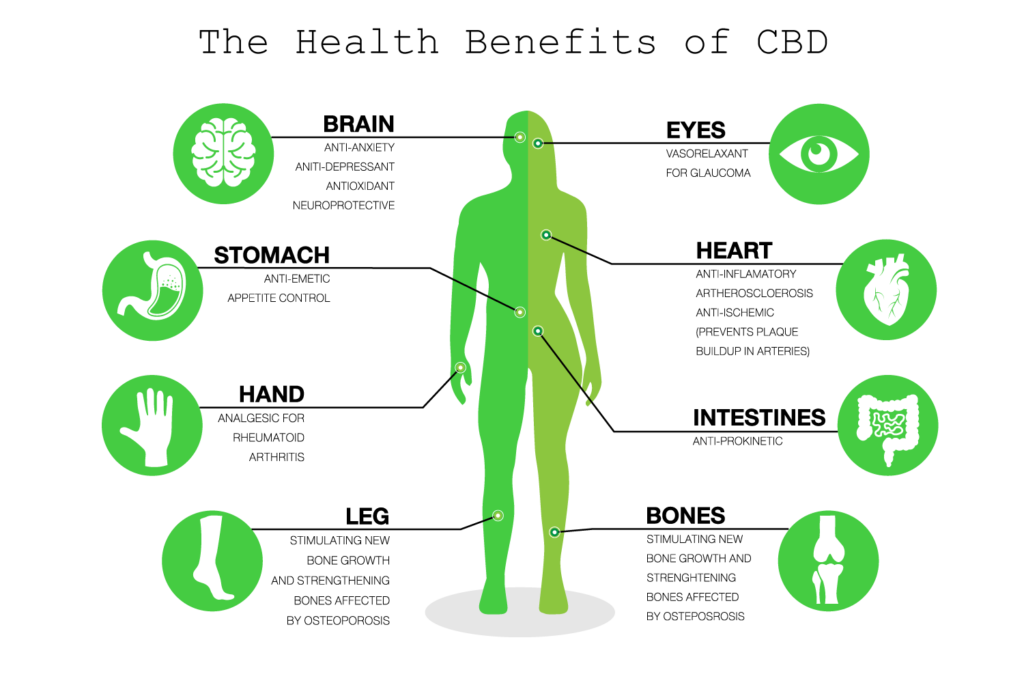
What Are the Side Effects of CBD?
Just like any health supplement, there are some side effects of CBD.
While these side effects are generally very mild in nature, it’s possible for more severe side effects to occur as well — especially if used in combination with other supplements, medications, or underlying health conditions.
It’s important to always speak with your doctor about using CBD if you have any underlying health problems.
Related: CBD Oil Drug Interactions List
Side Effects of CBD May Include:
- Low blood pressure (defined as blood pressure below 110/80 mm Hg)
- Dry mouth (Xerostomia)
- Fatigue or drowsiness
- Diarrhea
- Poor appetite
- Nausea and vomiting
- Skin rash
What to Expect When Taking CBD For the First Time
Depending on your symptoms, you may find relief immediately after taking CBD — while other times you’ll need to be patient and keep taking the CBD supplements for a few days, weeks, or even months before you start to notice any signs of improvement.
It’s important to keep a realistic expectation when using any medication or supplement for a particular symptom or medical condition.
Think of it like this — if your symptoms took a long time to develop, they’ll likely require a long time to leave again as well.
Conversely, if your symptoms appeared quickly, they will tend to leave quickly.
Also see: What Does CBD Feel Like?
Estimated Time Until Signs of Relief Noticed From CBD Supplementation:
| Immediate (Same Day) | Short Term (Within 2 Weeks) | Long Term (More Than Two Weeks) |
| • Pain • Arthritis • Anxiety • Epilepsy • Glaucoma • Inflammation • Motion sickness • Mood disorders • Migraine • Multiple sclerosis • Nausea • Neuropathic pain • Post-traumatic stress disorder • Rheumatism • Stress • Insomnia • Spinal cord injury |
• ADD/ADHD • Acne Pain • Arthritis • Anxiety • Depression • Endocrine disorders • Epilepsy • Inflammation • Mood disorders • Multiple sclerosis • Neuropathic pain • Obesity • Obsessive-compulsive disorder • Post-traumatic stress disorder • Rheumatism • Stress • Insomnia • Spinal cord injury |
• ALS • Addiction • Alzheimer’s disease • Asthma • Atherosclerosis • Autism • Bipolar disorder • Cancer • Inflammatory bowel disease • Depression • Diabetes • Endocrine disorders • Fatty liver disease • Fibromyalgia • Heart disease • Huntington’s disease • Kidney disease • Metabolic syndrome • Mood disorders • Neurodegeneration • Obesity • Post-traumatic stress disorder • Parkinson’s disease • Prion disease • Schizophrenia • Traumatic brain injury |
Seek Other Measures To Improve Your Health: Don’t Rely on CBD Exclusively
It’s important to look at the path to healing as a lifestyle change, rather than a quick fix — especially for chronic disease. If you’ve become sick, something is causing it. Many times we’re not able to get to the root cause of it but reach for symptomatic relief in order to avoid letting it rule our lives.
While CBD can help with a lot of things, if you want the best outcome it’s important to take steps towards improving the potential source of the problem too.
If you’re anxious, visit a therapist to explore what might be causing it, and provide tools and insight into how you might be able to stem the source.
If you’re experiencing chronic pain, try visiting a nutritionist to work on your diet, go to the physio to restore the function of the joint or muscle, or take time to destress and relax — stress is a more common source of physical pain than you might expect.
CBD is a tool to help you achieve a higher quality of life — but it isn’t a cure. Focus on getting better through lifestyle and use CBD as a buffer to make your life easier while you get there. The goal is to get to a point where you don’t even need the CBD — not to take it for the rest of your life.
Learn More About How Long Does CBD Take For CBD To Work.

What’s The Dose of CBD?
Finding the dosage for CBD products is confusing because it can be different from one person to the next.
With that said, the average dose is between 20 and 40 mg — taken every 6–8 hours.
Factors that Can Affect The Dose For Each Individual:
- Genetic variability in the liver can affect CBD metabolism
- Some symptoms require different doses to produce results
- Reduced gut health can mean less CBD is absorbed into the bloodstream
- Other ingredients in the CBD product can enhance or reduce absorption
- Some people are much more sensitive to CBD than others
All these factors can compound together to make dosing very challenging for new users — but it doesn’t need to be this way.
The easiest way to find the right dose is to use our dosage calculator below to identify the ballpark estimate of what dose.
Depending on how the first dose felt, you can either increase or decrease the dose slightly each day until you get the effects you’re looking for.
CBD Dosage Calculator
Once you know the dose you should be taking per day; you can choose to separate it into two or three separate doses. You need to determine how much of the CBD product you have you will need to take to achieve this dose.
Capsules and gummies are easy because they usually tell you exactly how much CBD each piece has.
Oils are slightly harder to gauge as you first need to determine how much CBD per mL the oil has before calculating the amount you need to take to hit that dose.

What Type of CBD Products Should I Use?
There are so many different forms of CBD on the market it can be difficult to decide which one to spend your money on.
Here are a few examples to consider and the pros and cons of each:
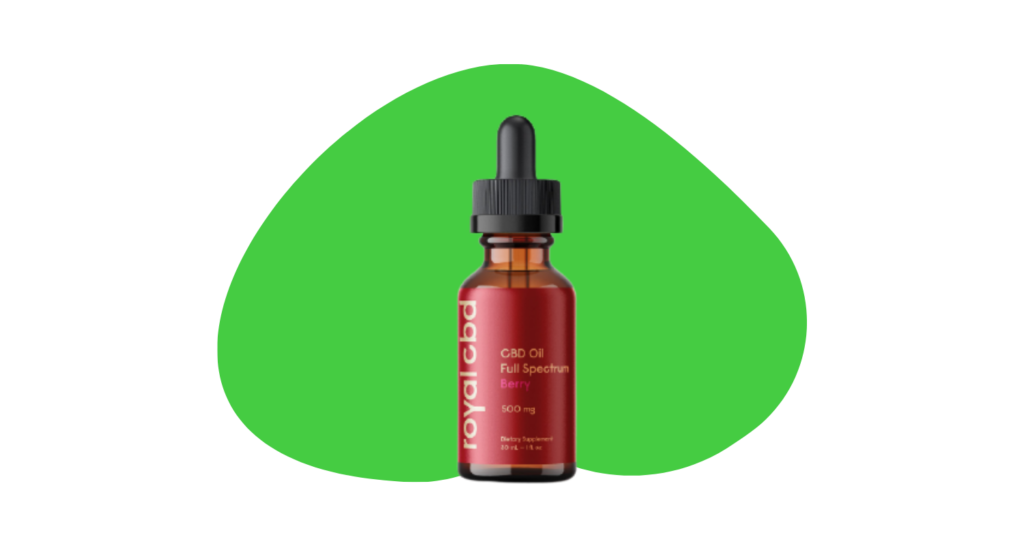
A) CBD Oils & Tinctures
Oils are the most common form of CBD products. They have several advantages over other methods of CBD products:
- They’re cost-effective
- They have a long shelf-life
- Doses can be accurately dialed in
- They can be mixed with other ingredients to further optimize for the intended use
CBD oil can be used for virtually any condition CBD may be indicated for — including skin conditions.
If you’re not sure where to begin, CBD oils are a safe place to start.
Depending on what you’re using CBD for, it’s better to find something in the middle to high-potency range. These oils are going to have the most versatility. You can take high doses or dilute them down to lower doses if needed.
Most people can hit an accurate dose with a high-potency CBD oil even if they take relatively small doses.
Higher potency oils are almost always the most cost-effective option as well — averaging about $0.09 per mg of CBD.
This compares to low potency oils that tend to average closer to about $0.14 per mg of CBD.
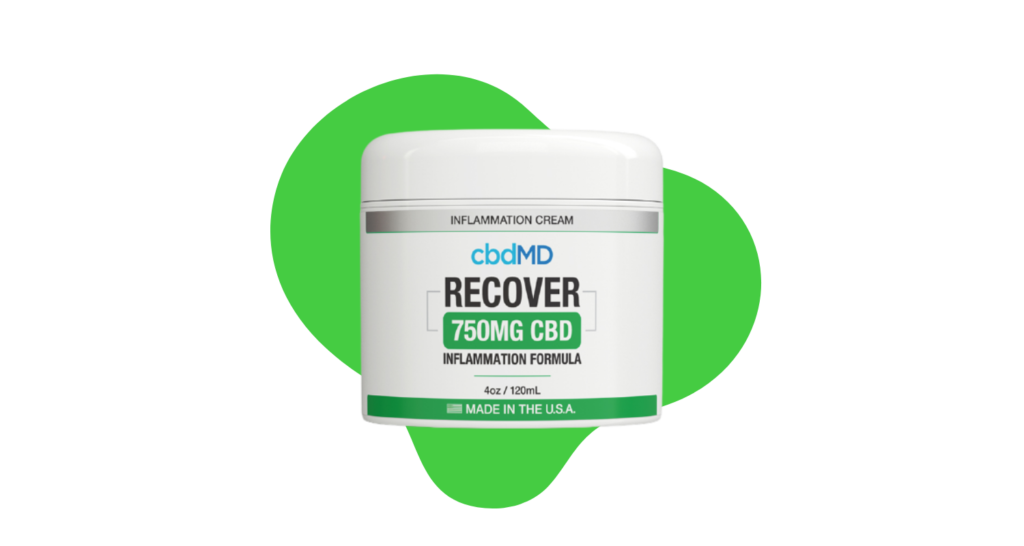
B) CBD Topicals
Topical CBD products are great for anything involving the skin, muscles, or joints. It delivers the CBD and other ingredients directly to the site.
Most CBD topicals on the market don’t have a high enough concentration of CBD to be of any real value for treating more severe symptoms — however, they may still be useful for mild symptoms or in general skincare.
The best topical CBD products have a potency of at least 10 mg/mL CBD and will include other beneficial ingredients like other herbal extracts as well.
Most CBD topicals contain closer to 4 mg/mL — which is still going to be effective for all but the most severe symptoms.
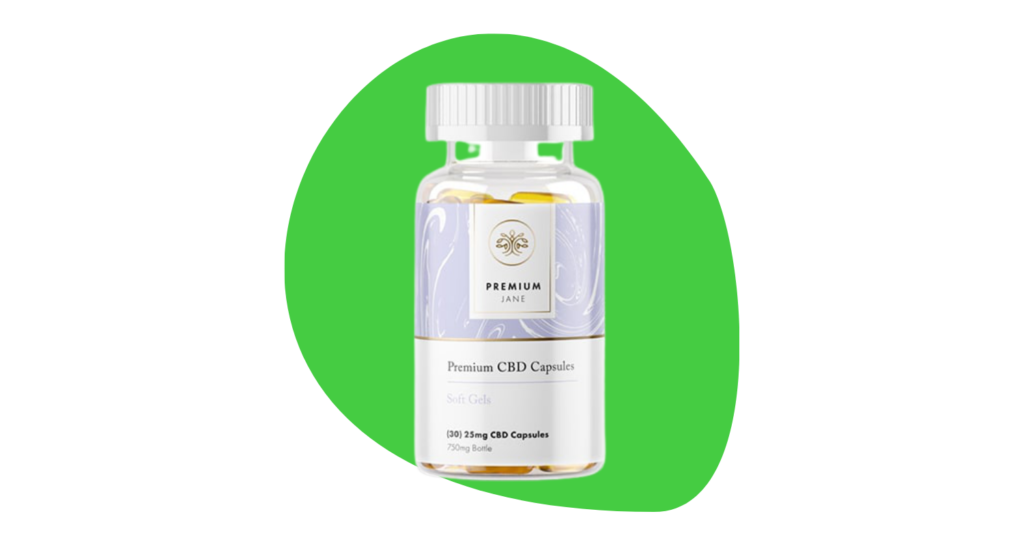
C) CBD Capsules
CBD capsules can be used for the same applications as CBD oils and tinctures.
The difference is that capsules come in pre-measured doses of CBD — so there’s no need to measure out your daily dose.
The tradeoff is that you have less control over the dose you’re getting with capsules, and they tend to be slightly more expensive than equivalent oils.
CBD capsules are great for anybody looking to make their CBD supplementation as simple as possible. You can find CBD capsules in multiple different potencies depending on your size and intended use.

D) CBD Suppositories
The CBD will be absorbed into the bloodstream through capillaries in the rectum. Most people would understandably prefer the other CBD options as they’re less invasive.
Where suppositories truly shine is with lower digestive discomfort. Conditions including inflammatory bowel disease (IBD), irritable bowel syndrome (IBS), and various other digestive tract disorders may have a lot to benefit from by introducing CBD directly to the source of the issue.
CBD suppositories are specialized products and will tend to be higher pricing than average compared to other CBD products.
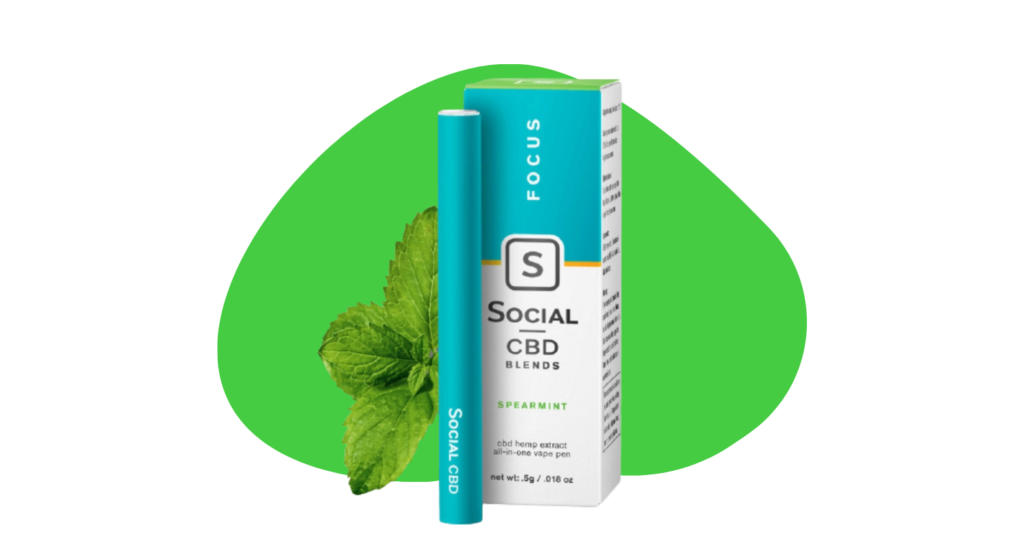
E) CBD Vape Oils & Vape Pens
Vape pens and vape oils (e-liquids) are some of the most popular categories of CBD products.
They’re convenient, highly portable, and provide fast-acting results. You can find all shapes and sizes of vape oils and pens, in almost every flavor imaginable. You can also find options that create vape clouds, and others that don’t if you’d prefer to be more discrete.
Vape oils and pens are great for people who need all-day relief or simply enjoy vaping as a way of taking their daily doses of CBD.
The downside of vaping is that it’s still too new to know the extent of the long-term negative health effects of the practice.
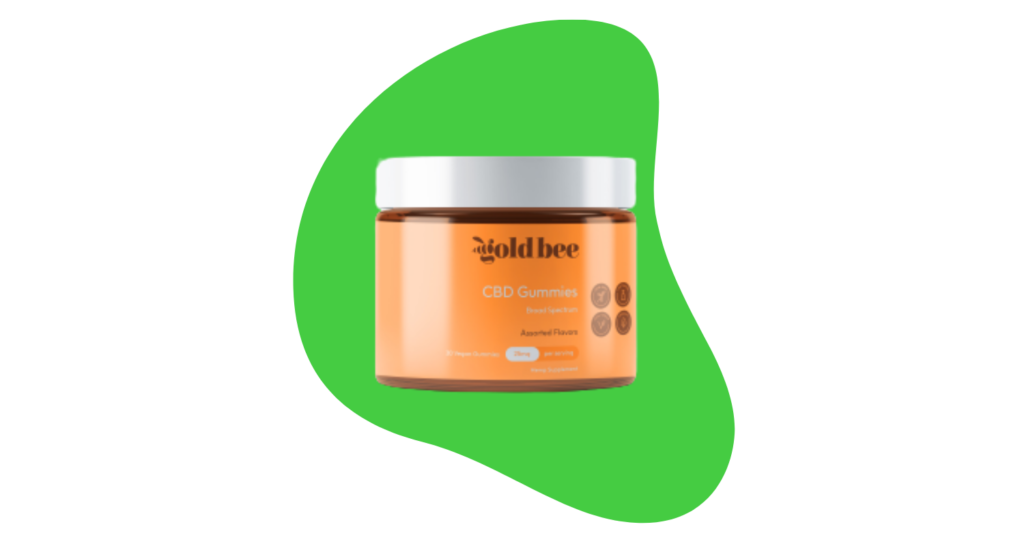
F) CBD Gummies
CBD extracts can be added to edibles to make a more enjoyable CBD supplement. They’re often added to cooking oils or butter and can be added to gummy candies as well.
They taste great and work much like a CBD capsule.
CBD gummies and other forms of CBD edibles are excellent products for those taking CBD casually for mild to moderate symptoms — but shouldn’t be relied on for larger doses. Large doses of CBD from gummies also mean large doses of sugar (which isn’t going to do us any favors towards our health).
This is also the preferred method many parents are using to give CBD to children with chronic illnesses.
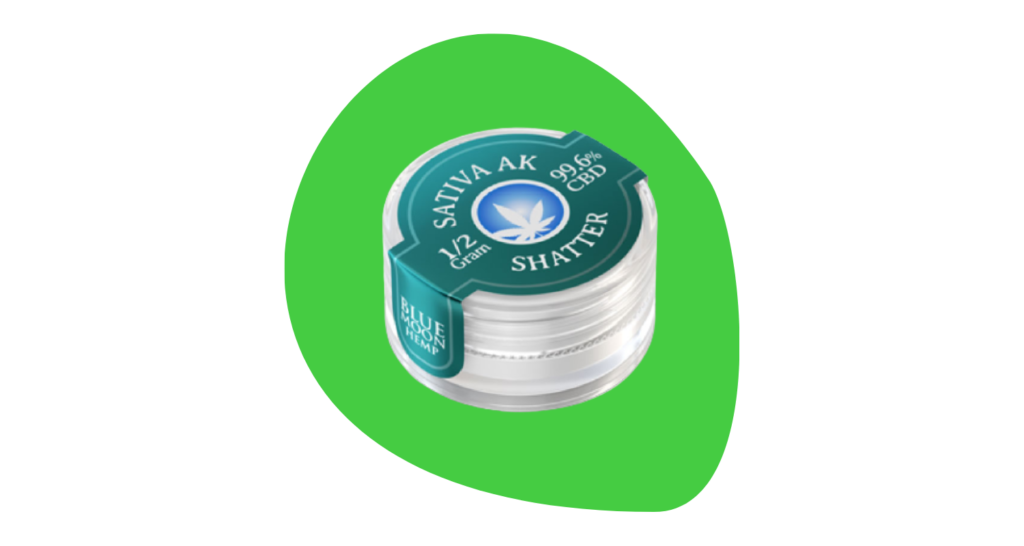
G) CBD Concentrates
A CBD concentrate is a purified extract of either CBD isolate or full-spectrum extracts.
CBD isolates are pure (isolated) CBD and generally come in the form of a white crystalline powder. This form of CBD concentrate is referred to as CBD crystals.
Full-spectrum extracts contain other cannabinoids, terpenes, and other phytochemicals — giving it more of a waxy, resinous appearance instead. This form of CBD concentrate is referred to as CBD waxes or dabs.
Most CBD oils, capsules, and gummies are made from a CBD concentrate that’s been diluted into a carrier medium for easy dosing. Concentrates can, therefore, be used in the same way as these other products, but require more care and attention to avoid taking too strong a dose.
CBD concentrates are a great option for people who need a larger dose of CBD to find relief from their symptoms. They’re also a good option for people looking to make their own CBD topicals, capsules, gummies, or oils.
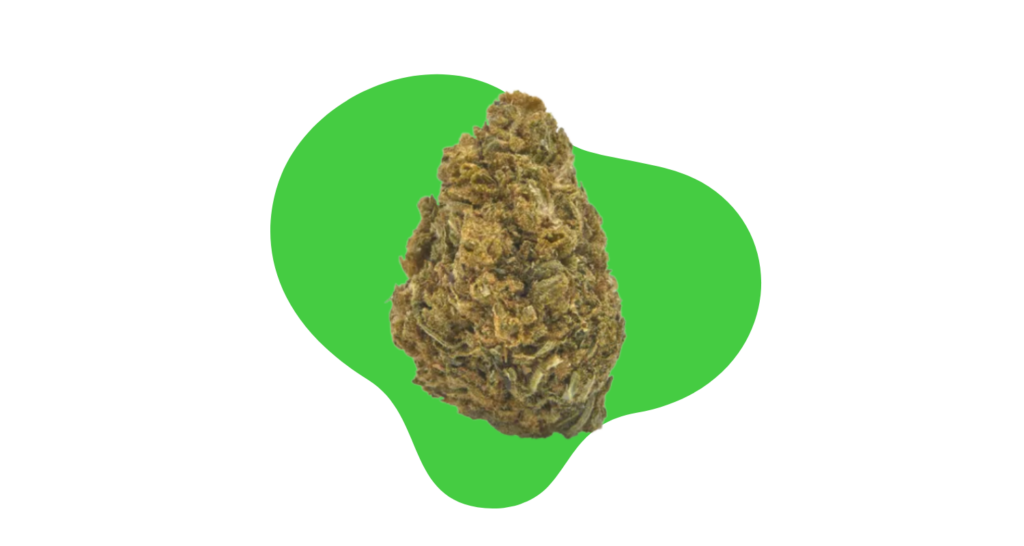
H) CBD-Rich Hemp Flower
The oldest method of using cannabis is to smoke the raw flower buds. This is still a viable method of getting CBD (and other phytocannabinoids) into the body.
Companies like Industrial Hemp Farms sell cured hemp flowers in the same way you would have bought marijuana. you can grind it up to use in a bong or roll into a joint.
My preferred method is to use a dried herb vaporizer instead. These devices heat the flower enough to cause the cannabinoids to evaporate — but without causing it to combust.
It’s the combustion reaction that creates all the nasty byproducts that make smoking so bad for our health.
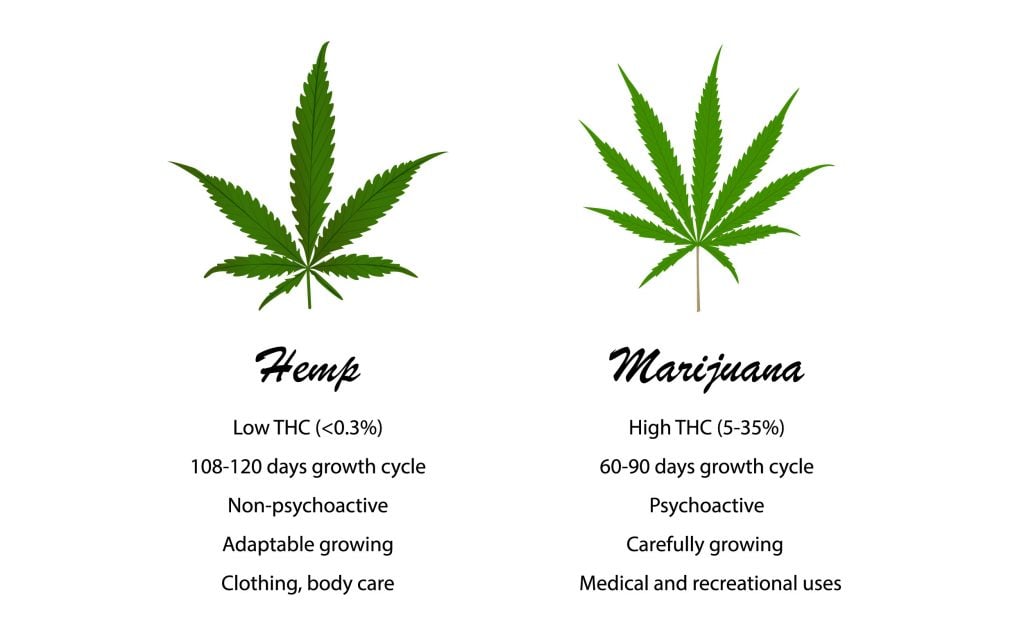
Hemp vs. Marijuana: What’s The Difference?
One of the most confusing aspects of cannabis-based products is the difference between hemp and marijuana. This is an important distinction to make when considering the legality and therapeutic effects of a CBD extract.
Both of these plants are the same species (Cannabis sativa) — yet their growth habits are radically different.
The easiest way to understand the difference between marijuana and hemp is to compare it to different types of dogs.
Let me explain…
All dogs are the same species — Canis lupus familiaris — despite there being hundreds of clearly different types of dogs. A chihuahua and a wolf are both the same species of dog — despite having an incredible amount of physical differences between the two (size, shape, and habits/instincts).
Just like dogs, hemp and marijuana are different enough to warrant individual names and uses, but similar enough that they can still breed together and produce offspring.
The biggest difference in growth habits between the two is that hemp doesn’t produce THC in any meaningful supply. Instead, hemp focuses its attention on producing other cannabinoids, like CBD and CBC.
Marijuana, on the other hand, has been selectively bred for its THC content. These plants will produce high concentrations of both THC and CBD as well as any of the other cannabinoids the cannabis plant is capable of manufacturing.
Cannabinoid Profile Comparison of Hemp & Marijuana
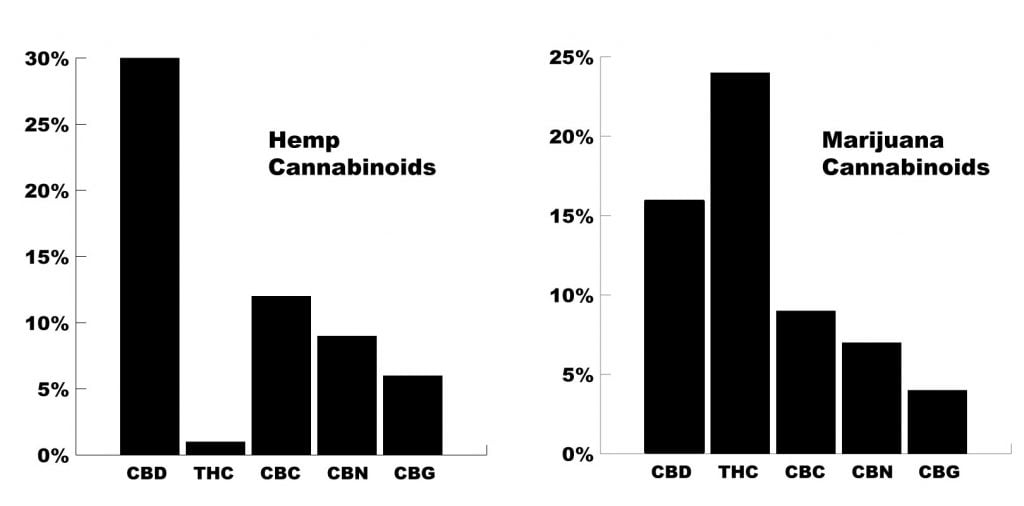
(These cannabinoid profiles are just examples — these values can vary significantly from one strain to the next).
CBD oils made from marijuana may contain THC, while CBD oils made from hemp don’t contain any psychoactive doses of THC.
In the United States, and throughout most of the world, hemp is considered legal due to its inability to produce THC (and therefore psychoactive effects), while marijuana is restricted or illegal for its intoxicating side effects.
Depending on which country you’re living in, these laws can vary significantly. Always check your local laws before buying any hemp or marijuana oils to avoid legal troubles. Even individual state laws can vary from the regulations imposed by the federal government.
Is CBD Legal?
Prior to 2018, all cannabis-derived compounds were considered a Schedule I drug. However, as a result of the 2018 Farm Bill, signed by President Trump, all derivatives of the non-psychoactive hemp plant were removed from the list of controlled substances — essentially making them legal.
This includes CBD, CBC, CBG, CBN, and delta 8 THC.
You now can buy CBD products in all 50 states without a medical license as long as it’s made from hemp and contains no more than 0.3% delta 9 THC by weight. CBD is considered a dietary supplement by the FDA.
Outside of the states, CBD is legal in most parts of the world, including Canada, Mexico, most of Latin America, the United Kingdom, Germany, Spain, Portugal, France, Australia, and more.
In medical marijuana states, patients can gain access to CBD products made from marijuana that contain various ratios of THC as well.
Learn more about the legal status of CBD.
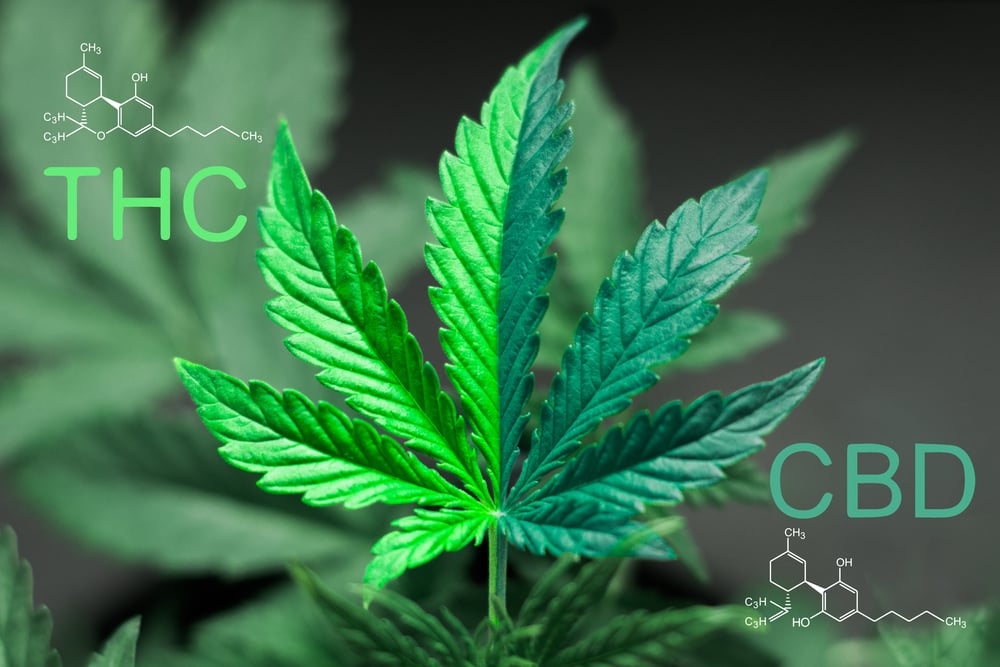
Comparing CBD With The Other Cannabinoids
There are at least 66 separate cannabinoids in the cannabis plant. Each one has a similar chemical structure and the ability to interact with the endocannabinoid system.
With so many cannabinoids in the plant, it’s useful to use a shortened naming system.
Common Cannabinoids and Their Abbreviations:
- Cannabidiol — CBD
- Cannabidivarin — CBDV
- Cannabichromene — CBC
- Cannabigerol — CBG
- Cannabinol — CBN
- Tetrahydrocannabinol — THC
- Tetrahydrocannabivarin — THCV
Now let’s compare the similarities and differences between CBD and some of the other prominent cannabinoids.
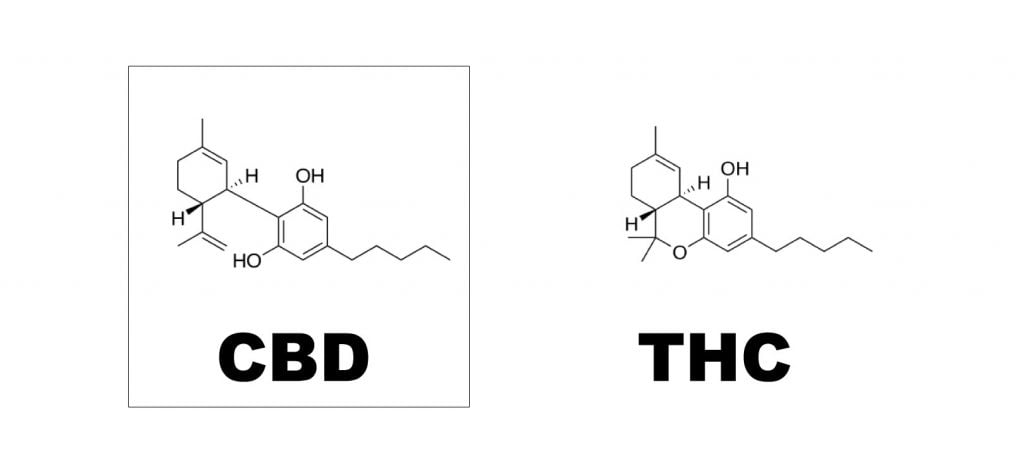
1. CBD vs. THC
Although structurally the two are very similar, these two cannabinoids have very different effects on the body.
As we’ve mentioned, THC (tetrahydrocannabinol) is the main reason marijuana offers psychoactive effects when smoked.
While CBD works to prevent the breakdown of naturally occurring endocannabinoids like anandamide, THC directly activates the endocannabinoid receptors.
One of the side effects of this effect is the release of serotonin in the brain — which produces euphoric and mind-altering effects. Interestingly, the active ingredients in magic mushrooms and LSD (acid) also owe their hallucinogenic effects to their interaction with serotonin in the brain.
Related: Can I Mix Cannabis With Psychedelics?
THC is mildly stimulating, which can be useful for conditions involving fatigue or low motivation — however, these same effects can make THC a problem for people with conditions like anxiety, insomnia, or schizophrenia.
There’s more than one type of THC. The main form is delta 9 THC — which is produced in large quantities in the marijuana plant.
There’s also delta 8 THC — which is actually derived from CBD and is the only legal form of THC in non-recreational marijuana states.
Delta 8 THC shares the most similarities with CBD — it’s often considered the middle-ground between delta 9 THC and CBD. It’s powerfully relaxing, offers strong anti-inflammatory effects, and can be used as a sedative — yet also provides psychoactive effects.
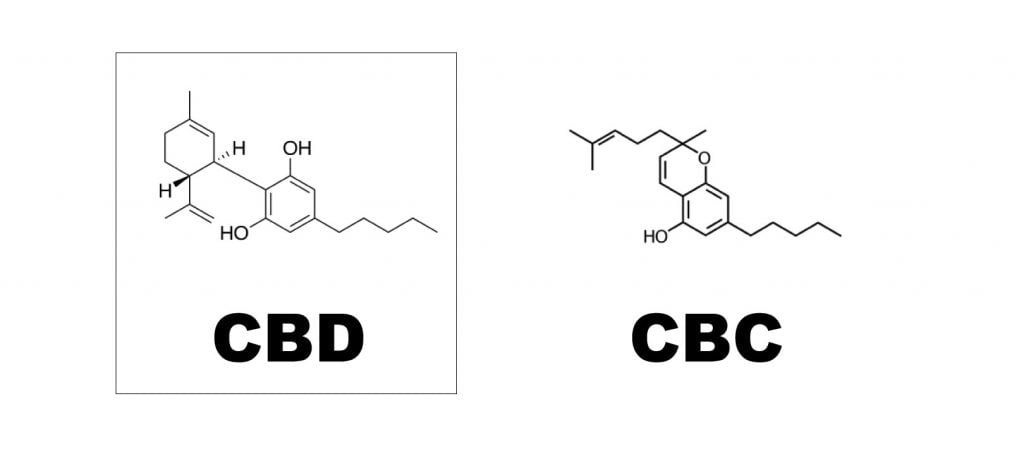
2. CBD vs. CBC
CBC stands for cannabichromene. It’s the third most abundant cannabinoid in the cannabis plant. Like CBD, CBC is non-psychoactive and has a relaxant effect on the central nervous system.
Some preliminary research even suggests that CBC is as useful, if not more useful for treating anxiety than CBD.
We’re starting to see many more products centered around CBC these days. It’s often used in topical skincare products for its ability to support the health of the skin and fight acne.
There’s also a varin sub-type of this cannabinoid called CBCV.
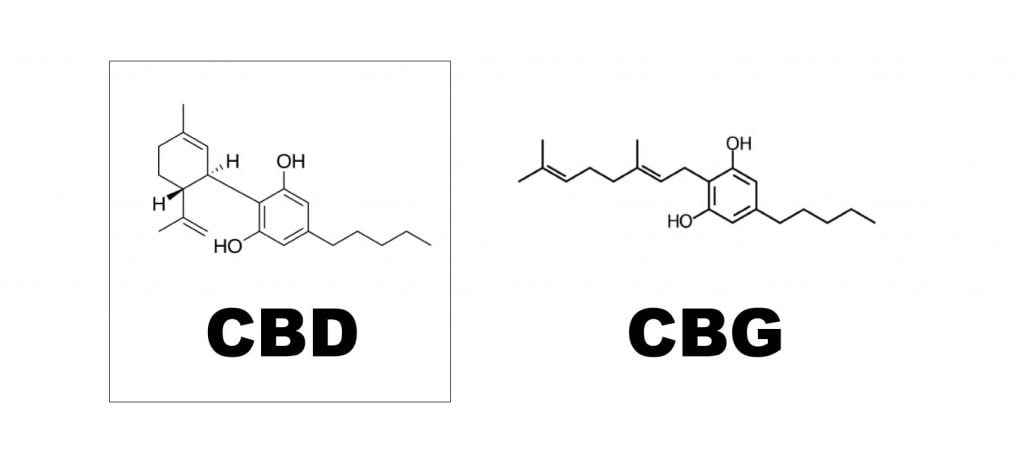
3. CBD vs. CBG
CBG stands for cannabigerol — it’s the precursor molecule for THC, CBD, and CBC among other lesser cannabinoids.
The cannabis plant produces CBG before it moves through other stages to become other cannabinoids depending on the plant’s genetics and growing environment.
Plants harvested early are more likely to have high CBG content.
CBG has been shown to block the effects of THC on serotonin [2] and can, therefore, reduce many of the common side-effects of THC including euphoria, anxiety, and paranoia.
More research is needed to fully understand the medical value of CBG — at the moment, there isn’t much focus on this cannabinoid.
There’s also a varin sub-type of CBG called CBGV.
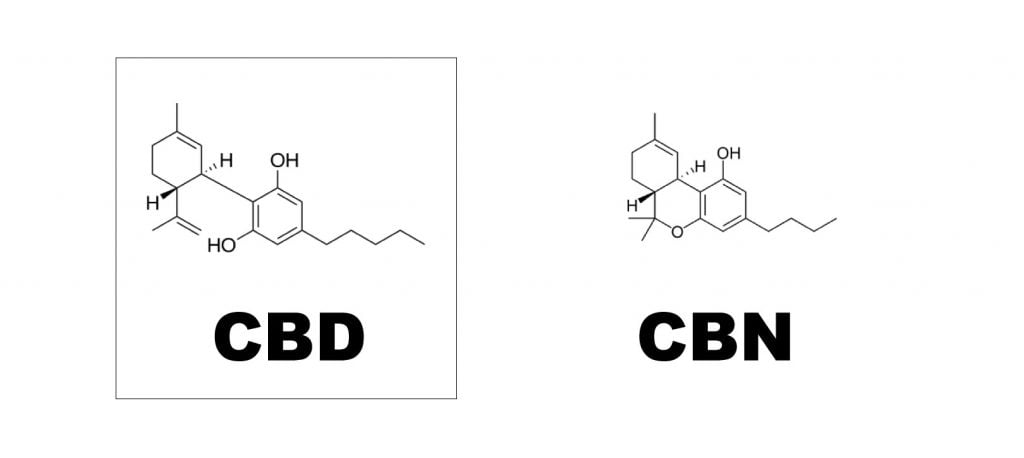
4. CBD vs. CBN
CBN (cannabinol) is the opposite of CBG — it’s produced as CBD and THC degrade into smaller compounds.
Hemp plants that are harvested late will be higher in CBN. Additionally, cannabis that has been stored improperly (too dry, or too long) will also be higher in CBN.
This cannabinoid is mildly psychoactive in sensitive individuals. Its primary effects are to provide a heavy, sedating sensation — making it especially useful for treating insomnia, stress, obsessive-compulsive disorder (OCD), or anxiety.
We’re starting to see a few CBD products hitting the market that contains CBN as a way to boost the sedative effects of the cannabinoid overall.
5. CBD Vs. THCC
THCC (tetrahydrocannabiorcol) is essentially a THC molecule with just one carbon atom in its alkyl side chain.
This side-chain dramatically affects a cannabinoid’s ability to interact with the endocannabinoid receptor. Researchers have discovered that there needs to be at least three carbon atoms here for a cannabinoid to have psychoactive effects.
THCVV (tetrahydrocanabivarin) has three carbon atoms in this chain and is mildly psychoactive (about 25% as strong as delta 9 THC).
THCC only has one and is therefore non-psychoactive. Its effects are more similar to CBD than to THC.
This cannabinoid has only a minor action on the endocannabinoid system but provides strong actions on another receptor subtype called TRP. TRP receptors act like sensors that detect noxious chemicals in the body. A lot of the benefits of CBD stem from its ability to interact with these receptors — such as its effects on neuropathic pain, osteoarthritis, and a variety of neurological disorders.
As THCC is even better for interacting with the TRP system, it’s likely this cannabinoid is even better for conditions like muscular dystrophy, autism, low-grade osteoarthritis, and various forms of neuropathy.
6. CBD vs. CBDV
CBD and CBDV (cannabidivarin) are two totally separate compounds. Both offer a similar set of benefits — each with its own sets of advantages and disadvantages.
CBDV is far less studied than CBD, but preliminary research suggests it could be the better option for neuropathic pain. CBDV is able to bind to the TRP receptors more efficiently but isn’t as bioavailable as CBD. CBDV also appears to be less effective than CBD for managing seizures or inflammation.
Full-Spectrum vs. Broad-Spectrum vs. Isolate
There are three main philosophies when it comes to deciding what cannabinoid profiles a company should use in their products — full-spectrum, CBD isolate, and broad-spectrum CBD oils.
The only way to prove a product is full-spectrum, broad-spectrum, or isolate-based is to look at third-party lab tests — so I’ll include an example for each so you know what to look for.
A) Full-Spectrum Extracts
As the name implies, a full-spectrum extract contains all the cannabinoids naturally found in the Cannabis sativa plant (hemp). There will be large amounts of CBD with smaller concentrations of CBC, CBG, CBN, and other cannabinoids.
Full-spectrum extracts are a more direct representation of the cannabis plant as a whole.
Along with all the various cannabinoids in the plant, full-spectrum extracts will also provide the terpenes, lignins, polyphenols, and various other phytochemicals found in the cannabis plant — which have medicinal effects of their own.
Generally speaking, a full-spectrum extract is considered more potent than isolates. This is due to a concept commonly known as “the entourage effect.”
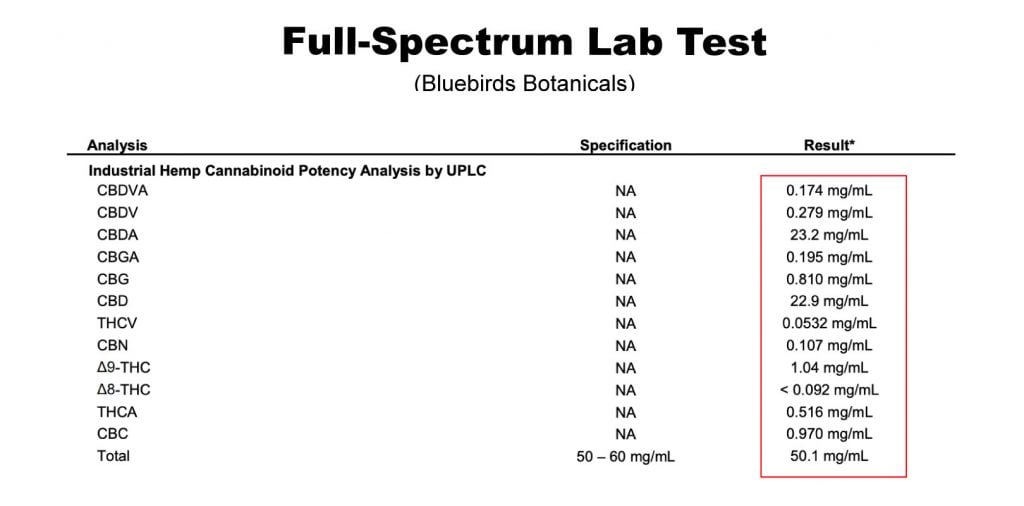
(Example lab test for a full-spectrum extract — notice how many different cannabinoids register on the test)
B) CBD Isolates
CBD isolates are manufactured by adding another purification step to the process.
Once the phytochemicals are extracted from the leaves and flowers of the plant, an extra process called chromatography is used to separate the CBD from the rest of the chemicals.
This results in a pure CBD extract — free from all the other phytochemicals.
CBD isolates will form a white crystalline substance. Products made with CBD isolates tend to be cheaper than full-spectrum. This is because despite having extra steps involved with manufacturing, it allows companies to use low-quality hemp to make the extract since most of the other constituents and potential contaminants will be removed during the isolation process anyway.
Isolates tend to require higher doses than full-spectrum extracts to produce the same results. They lack the additional therapeutic benefits of the other cannabinoids and terpenes in the cannabis plant.
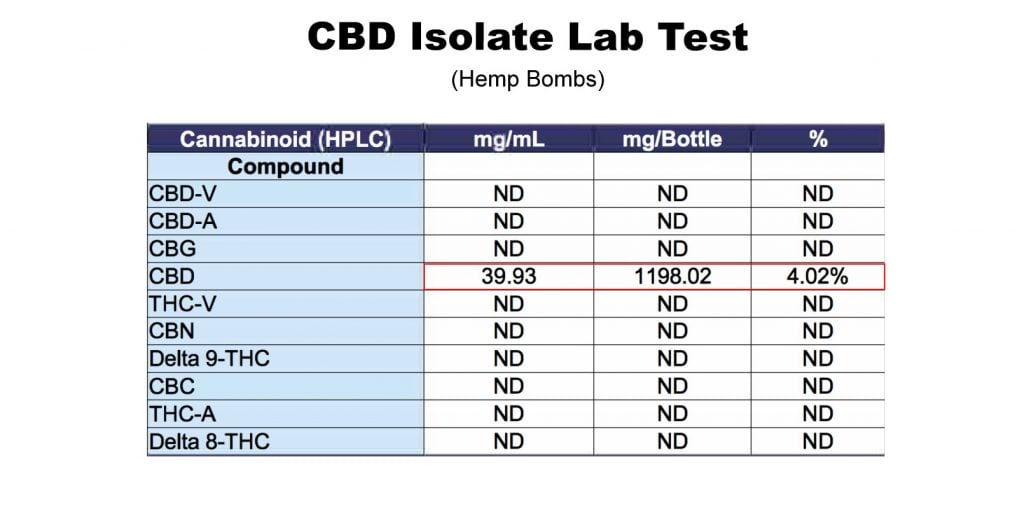
(Example lab test for an isolate-based extract — notice how only CBD appears on the test)
C) Broad-Spectrum Hemp Extracts
There is also a third type of CBD extract not commonly discussed — called broad-spectrum extracts. Some companies are calling these “controlled-spectrum” extracts.
They’re made by first separating the cannabinoids and terpenes into their individual components before recombining them in specific ratios. They mimic a full-spectrum extract but aren’t nearly as diverse.
These extracts will look a lot like a full-spectrum extract on a lab test but are synthetically formulated from various isolates (CBD isolate, CBC isolate, CBG isolate, etc.).
Broad-spectrum extracts can vary a lot in their effects depending on the cannabinoid ratios. Many manufacturers will also add terpenes to the final product.

(Example lab test for a broad-spectrum extract — notice how some cannabinoids appear while others don’t)
The Nitty Gritty: How Does CBD Actually Work?
CBD is a potent medicinal compound shown to provide symptomatic support for a long list of medical conditions and symptoms including epilepsy, anxiety, chronic pain, nausea, insomnia, multiple sclerosis, neurodegenerative disorders, and endocrine disorders.
How can one simple compound have such a diverse list of medical benefits?
As mentioned previously, the answer lies in CBD’s ability to interact with a system in the body that’s involved with homeostasis — the ECS.
This means that CBD regulates a system designed to keep us in balance, turning processes down when they become overactive, and turning them up when they are deficient.
This is very different from other medications or supplements — which usually have a specific direction of effects, either increasing or decreasing a given process in the body.
Let’s explore how CBD works in more detail:
1. CBD Boosts Endocannabinoid Levels (FAAH Inhibitor)
CBD inhibits an enzyme known as FAAH (fatty acid amide hydrolase). This enzyme is responsible for breaking down endocannabinoids inside the cells.
CBD inhibits FAAH, providing a boost in our naturally occurring endocannabinoids 2-AG and anandamide [3].
This is the main mechanism CBD uses to provide support for homeostasis. It’s the reason why CBD is thought to provide a “balancing effect” rather than forcing a reaction in the body in one direction or another.
2. CBD Activates the Vanilloid Pain Receptors
When you activate the vanilloid pain receptors, the result is a blockage of pain signals to the brain.
The vanilloid receptors have many responsibilities in the human body including regulating pain transmission, inflammation, and body temperature. There are several other herbs that interact with these receptors to produce medicinal effects, including ginger, black pepper, and chili peppers [14] — all of which are well known for their analgesic effects.
CBD activates the TRPV1 vanilloid receptors directly — reducing the intensity of pain signals being sent to the brain and broadly lowering inflammation throughout the body [4].
3. CBD Increases GABA Activity
GABA (gamma-aminobutyric acid) is our primary relaxing neurotransmitter. It acts as the brake pedal on the nervous system. When we start moving too fast (mentally overstimulated), GABA steps in to slow us down.
GABA is important for sleep hygiene because it prepares the mind to fall asleep at night.
This neurotransmitter is also necessary immediately following stress. It’s what reverses the process, slowing our heart rate, lowering blood pressure, and allowing us to relax and recover.
When GABA isn’t working properly, we may become anxious and find it difficult to turn off the stress response or fall asleep — resulting in anxiety, and insomnia.
GABA dysfunction can indirectly lead to lowered immunity, as well as digestive problems if the issue persists for long periods.
CBD is an allosteric modulator of GABA. This is a fancy term that means CBD doesn’t activate the GABA receptor directly — rather, it makes it easier for naturally occurring GABA to bind to the receptors [5].
The result is an increased feeling of relaxation, and lowered symptoms of hyperstimulation in the brain (anxiety, insomnia, PTSD, etc.).
This is also how a lot of prescription anti-anxiety medications work — such as benzodiazepines (i.e., Xanax, Valium, or Klonopin).
Unlike benzodiazepines, however, CBD is not addictive. There are no withdrawal symptoms when you stop taking CBD, even after many years of regular use.
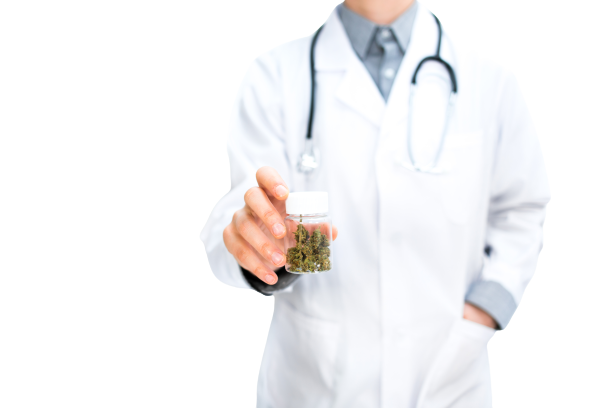
CBD in the Medical Research — Evidence-Based Benefits of CBD
There are claims that CBD can cure just about everything these days — which obviously isn’t true. CBD is not a miracle cure and has limitations in what it can effectively treat.
Differentiating between exaggerated claims and reasonable recommendations for CBD can be difficult — especially with the limited amount of research available.
Keep in mind that CBD was virtually unknown to mainstream science 20 years ago, and research is a slow-moving process. It can take upwards of 10 years for the research to catch up to public health trends.
Here are some of the medical uses of cannabis that have the most evidence behind them.
1. CBD & Inflammation
CBD is a powerful anti-inflammatory compound [15] — in fact, its anti-inflammatory effects could be argued as a reason why CBD is so effective for other health conditions as well.
Chronic (long-term) inflammation is associated with many different medical conditions, including inflammatory bowel disease, Parkinson’s disease, Alzheimer’s disease, arthritis, kidney disease, multiple sclerosis, and much more.
CBD targets the inflammatory process at multiple levels. It’s been shown to inhibit a host of inflammatory markers that work together to drive inflammation in the body.
This broad anti-inflammatory effect makes CBD useful for a host of symptoms related to inflammation, as well as protective effects on long-term health conditions including fatty liver disease, atherosclerosis, kidney disease, and inflammatory bowel disease.
2. CBD & Anxiety
Anxiety has many potential causes — nutritional deficiencies, traumatic events (PTSD), chronic stress, medication side effects, drug addiction, sleep deprivation, or metabolic disorders, for example. This diversity in potential causes can make treating anxiety difficult.
CBD provides some unique benefits towards treating anxiety, through its ability to enhance GABA activity, support sleep quality, reduce muscle tension, and improve symptoms related to gut health and inflammation that can indirectly lead to anxiety symptoms.
A clinical trial published in 2011 investigated the effects of CBD versus placebo on social anxiety disorder in a model involving public speaking as the source of anxiety [16]. Twenty-four participants with a social anxiety disorder were asked to speak in front of a camera. Baseline anxiety scores were taken before the event, as well as afterward.
The study found that those in the treatment group (taking CBD) experienced a rapid reduction in anxiety scores both before and after the public speaking event when compared to the placebo control.
A phase 3 randomized clinical trial is also currently underway exploring the effects of a CBD oil capsule on patients with various forms of anxiety and panic disorders. This study is significantly larger and will likely become a key piece of evidence for the use of CBD on anxiety when it comes to an end.
This effect has proven useful for neurodiverse children (including autism spectrum disorders and ADHD) that suffer from social anxiety.
3. CBD & Epilepsy
There’s a lot of research on the use of CBD for epilepsy — with several large clinical trials already published on the topic. Epilepsy is also the focus for an upcoming CBD and THC-based pharmaceutical antiepileptic drug known as Sativex [8], as well as similar medications like Epidiolex.
A 2016 cohort study, involving 74 patients with treatment-resistant epilepsy (including Dravet syndrome), gave participants a CBD-enriched hemp oil (20:1 CBD: THC ratio) for an average of 6 months. 89% of the participants in this study reported a reduction in the number of seizures they experienced [7].
Additionally, researchers noted other improvements in the patients’ behaviors, including increased alertness, communication, motor skills, and sleep quality.
4. CBD & Pain
Pain is another area with plenty of research to back up the claims made for the uses of CBD. There are a few qualities of the compound that make it an attractive option for pain relief over other alternatives:
- CBD is not physically addictive
- CBD is effective in different types of pain
- CBD offers pain reduction through several unique mechanisms
A recent review article by Ethan Russo — a medical cannabis researcher — presented a series of randomized clinical trials involving pharmaceutical preparations of CBD and THC extracts (Nabilone, Sativex, and Marinol) and their effect on various types of pain [9].
The studies listed in the review show that CBD and THC can be used to alleviate different forms of pain, including:
- Neuropathic (nerve) pain
- Multiple sclerosis pain
- Postherpetic neuralgia
- Post-operative pain
- Intractable pain
- Rheumatoid arthritis pain
- Spinal cord injury pain
- Cancer pain
- Urinary tract pain associated with MS
5. CBD & Multiple Sclerosis
One of the leading pharmaceutical cannabinoid preparations (Sativex) was approved for use as a treatment for multiple sclerosis by the FDA (Food and Drug Administration) in 2018. It was shown to improve common side effects of MS including muscle spasms [10], bladder dysfunction [11], and nerve pain [12].
CBD, in particular, has been shown to provide some preventative effects on MS — characterized as an autoimmune disease involving the destruction of myelin on the nerves by T-cells. CBD inhibits problematic T-cells from migrating towards the microglia of the brain where it would normally trigger inflammation and degeneration of myelin [13].
Related: What’s the Best CBD:THC Ratio for Multiple Sclerosis?

When to Avoid CBD
CBD isn’t for everyone — here are some of the most important times when someone should avoid using CBD.
A) With Severe Depression
CBD is often suggested as a treatment for depression. While there is strong merit for this with mild to moderate depression — it may not be suitable for those with severe chronic depression.
A large meta-review analyzed 57 separate studies involving cannabis and depression to identify whether or not regular cannabis use was associated with depression. The study concluded that long-term cannabis use increased the risk of depression [6].
Anybody suffering from severe depression should refrain from using CBD or other cannabis products without supervision by a licensed medical professional.
CBD may also interact negatively with prescription antipsychotic medications. Caution is advised.
B) Alongside Benzodiazepine Medications
Benzodiazepine medications are used to treat anxiety and insomnia symptoms. They work by enhancing the effects of the neurotransmitter GABA — which is one of the ways CBD offers its anti-anxiety and sedative effects.
Drugs like Xanax and Valium are significantly more potent than CBD at doing this. However, they can result in serious side effects or potential for addiction if combined with other drugs or supplements that work through GABA.
Therefore it’s highly recommended that you avoid using marijuana or any CBD products alongside prescription benzodiazepine use.
Related: How people are kicking Xanax addiction with CBD.
C) In Places Where CBD is Illegal
Unfortunately, CBD is still considered illegal in some countries.
These laws are changing all the time, so you should look into your country, state, or province individually to keep yourself up to date on the laws of the place you’re living.
We don’t recommend using CBD in places where the compound is illegal.
Here are some alternatives you can explore if you check this box:
- Kava (Piper methysticum) — for anxiety, pain, and insomnia
- Kratom (Mitragyna speciosa) — for pain, stress, and anxiety
- Turmeric (Curcuma longa) — for pain and inflammation
- Frankincense (Boswellia serrata) — for pain, inflammation, and arthritis
- Ginkgo (Ginkgo biloba) — for neurodegeneration and heart disease/atherosclerosis
- Bacopa (Bacopa monieri) — for neurodegeneration, neurological disorders
What is the Endocannabinoid System (ECS)?
All animals have an endocannabinoid system (ECS). We even have specialized messenger molecules designed to work with the ECS, known as the endocannabinoids.
The compounds in cannabis — the phytocannabinoids — are just the right shape that they can interact with the ECS.
The ECS consists of a series of specialized receptors that control intracellular activities (activities happening inside the cell). This system is primarily involved with maintaining homeostasis (balance throughout the body), as well as protecting organs from chronic damage caused by exposure to toxic substances or inflammation.
Homeostasis refers to the ability of an organism to maintain a consistent, well-balanced internal environment.
Everything from body temperature to blood pH needs to be kept within a tight window of control for us to remain healthy.
You may be wondering how the ECS helps us maintain homeostasis. The answer isn’t that simple, unfortunately. This system uses a series of highly complex cellular feedback mechanisms to maintain balance — turning processes up when they’re too low, and dialing them down when they’re too high.
The best way to think of how this system works is by looking at the ECS like the “read receipts” on a text message.
Let me explain.
You’re sending a text message — telling them something important, like where to meet you after work. When someone opens your message to read it, you’ll receive a notification to tell you the message was received and read. This lets you know that you don’t need to resend the same message again.
The endocannabinoid system works like the read receipts for the body. It’s designed to improve the body’s ability to communicate with itself to keep tighter control over homeostasis.
Whenever a message is sent from one cell to another, the endocannabinoid system sends a message back to the sender to tell it that the message has been received and the requests will be taken care of.
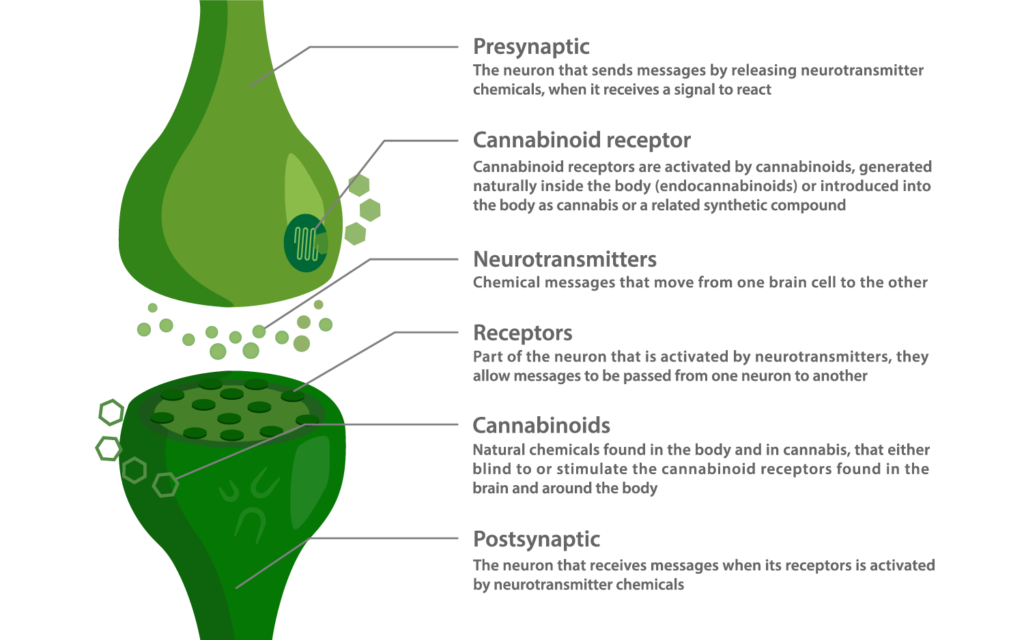
Where is the ECS?
The endocannabinoid system is found throughout the body.
Endocannabinoid receptors are found on virtually every organ (to some degree) but are most abundant in the central nervous system (brain and spinal cord) and immune systems.
In these systems, the endocannabinoid receptors play a pivotal role in the regulation of our nervous system — which is why CBD is so useful for conditions like anxiety and epilepsy. It’s also an exceptionally important component of the immune system — making CBD useful for reducing inflammation and supporting autoimmune disorders like multiple sclerosis or ALS.
The body uses two main hormone-like compounds to regulate this system — known as the endocannabinoids.
The first one is an eicosanoid compound known as anandamide, which is most similar to CBD and acts as a general regulator for this system.
The other primary endocannabinoid is 2-AG — which is more similar in its effects to THC — working as a direct activator for the endocannabinoid receptors (CB1).
There Are Two Types of Endocannabinoid Receptors:
1. CB1 Receptors
The CB1 cannabinoid receptors are most abundant in the central nervous system of the spinal cord and brain. These receptors are used to control neurotransmitters including dopamine, serotonin, and norepinephrine. Through these effects, the CB1 receptors play a role in the regulation of mood, sexual function, memory formation and retrieval, and overall cognitive health.
Most of the psychoactive effects of THC are due to an activation of the CB1 receptors in the spinal cord and brain, triggering a release of serotonin.
2. CB2 Receptors
The CB2 cannabinoid receptors are found throughout the peripheral tissues including the skin, muscles, and the immune cells. They’re used to regulate the release of cytokines — tiny messenger molecules used to send messages around the body to other immune cells.
Through its effect on the immune cells, CB2 receptors are used to boost immune function during infection and cancer and are involved with the process of inflammation, and autophagy (garbage disposal of damaged or infected cells around the body).
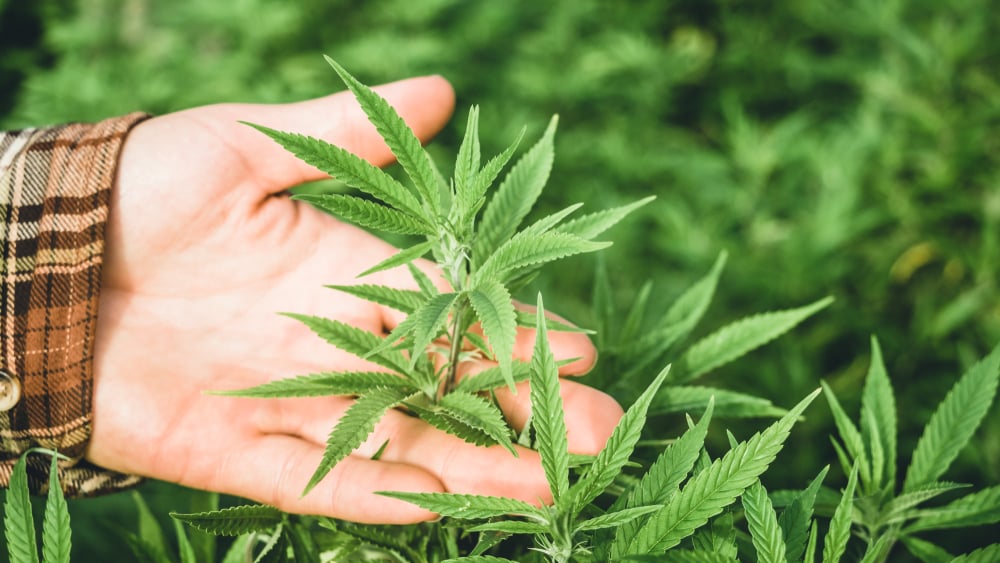
Summary: What is CBD?
CBD is a fairly new health supplement with a lot to offer for certain medical conditions or symptoms.
It’s a lot more complex than many other health supplements — due to the complexity of the endocannabinoid system it works through. This system is involved in keeping the organs throughout the body in balance (homeostasis). This gives CBD a bidirectional effect and makes it very hard for researchers to quantify.
Nevertheless, there are many uses for this supplement — the most difficult part is choosing which products to buy and how much to take.
Using our guidelines above, you can dramatically reduce the time it takes to find the right dose. Additionally, you can save your money by reading through our company and product reviews to avoid buying low-quality CBD products.
It’s also important to manage expectations when taking CBD — some symptoms may clear up immediately as the CBD begins to kick in, others can take a few weeks, or even months of regular use before benefits start to appear.
Be patient and persistent when taking CBD — and always consult with your doctor whenever using CBD or any other health supplement for a specific condition — especially if taking other medications at the same time.
References
- Sharma P, Murthy P, Bharath M.M.S. (2012). Chemistry, Metabolism, and Toxicology of Cannabis: Clinical Implications. Iran J Psychiatry 2012; 7:4: 149-156
- Cascio, M. G., Gauson, L. A., Stevenson, L. A., Ross, R. A., & Pertwee, R. G. (2010). Evidence that the plant cannabinoid cannabigerol is a highly potent α2‐adrenoceptor agonist and moderately potent 5HT1A receptor antagonist. British journal of pharmacology, 159(1), 129-141.
- Nelson, K., Walsh, D., Deeter, P., & Sheehan, F. (1994). A phase II study of delta-9-tetrahydrocannabinol for appetite stimulation in cancer-associated anorexia. Journal of palliative care.
- Bisogno, T., Hanuš, L., De Petrocellis, L., Tchilibon, S., Ponde, D. E., Brandi, I., … & Di Marzo, V. (2001). Molecular targets for cannabidiol and its synthetic analogues: effect on vanilloid VR1 receptors and on the cellular uptake and enzymatic hydrolysis of anandamide. British journal of pharmacology, 134(4), 845-852.
- Bakas, T., Van Nieuwenhuijzen, P. S., Devenish, S. O., McGregor, I. S., Arnold, J. C., & Chebib, M. (2017). The direct actions of cannabidiol and 2-arachidonoyl glycerol at GABAA receptors. Pharmacological research, 119, 358-370.
- Lev-Ran, S., Roerecke, M., Le Foll, B., George, T. P., McKenzie, K., & Rehm, J. (2014). The association between cannabis use and depression: a systematic review and meta-analysis of longitudinal studies. Psychological medicine, 44(4), 797-810.
- Tzadok, M., Uliel-Siboni, S., Linder, I., Kramer, U., Epstein, O., Menascu, S., … & Dor, M. (2016). CBD-enriched medical cannabis for intractable pediatric epilepsy: the current Israeli experience. Seizure, 35, 41-44.
- Guy, G. W., & Stott, C. G. (2005). The development of Sativex®—a natural cannabis-based medicine. In Cannabinoids as Therapeutics (pp. 231-263). Birkhäuser Basel.
- Russo, E. B. (2008). Cannabinoids in the management of difficult to treat pain. Therapeutics and clinical risk management, 4(1), 245.
- Notcutt, W., Langford, R., Davies, P., Ratcliffe, S., & Potts, R. (2012). A placebo-controlled, parallel-group, randomized withdrawal study of subjects with symptoms of spasticity due to multiple sclerosis who are receiving long-term Sativex®(nabiximols). Multiple Sclerosis Journal, 18(2), 219-228.
- Brady, C. M., DasGupta, R., Dalton, C., Wiseman, O. J., Berkley, K. J., & Fowler, C. J. (2004). An open-label pilot study of cannabis-based extracts for bladder dysfunction in advanced multiple sclerosis. Multiple Sclerosis Journal, 10(4), 425-433.
- Barnes, M. P. (2006). Sativex®: clinical efficacy and tolerability in the treatment of symptoms of multiple sclerosis and neuropathic pain. Expert opinion on pharmacotherapy, 7(5), 607-615.
- Kozela, E., Lev, N., Kaushansky, N., Eilam, R., Rimmerman, N., Levy, R., … & Vogel, Z. (2011). Cannabidiol inhibits pathogenic T cells, decreases spinal microglial activation and ameliorates multiple sclerosis‐like disease in C57BL/6 mice. British journal of pharmacology, 163(7), 1507-1519.
- Vennekens, R., Vriens, J., & Nilius, B. (2008). Herbal compounds and toxins modulating TRP channels. Current neuropharmacology, 6(1), 79-96.
- Burstein, S. (2015). Cannabidiol (CBD) and its analogs: a review of their effects on inflammation. Bioorganic & medicinal chemistry, 23(7), 1377-1385.
- Bergamaschi, M. M., Queiroz, R. H. C., Chagas, M. H. N., De Oliveira, D. C. G., De Martinis, B. S., Kapczinski, F., … & Martín-Santos, R. (2011). Cannabidiol reduces the anxiety induced by simulated public speaking in treatment-naive social phobia patients. Neuropsychopharmacology, 36(6), 1219
Explore the Best CBD Products
-
Conditions Related to Health Benefits
- CBD For Allergies: Can This Cannabinoid Ease Symptoms?
- Top 10 CBD Oils For Back Pain
- Can CBD Help With Menstrual Cramps?
- CBD for Sciatica: How It Works, Safety, Drug Interactions, & Best Products
- Is CBD a Viable Treatment for Cerebral Palsy?
- Anxiety & Depression
- Arthritis
- Muscle Recovery
- Weight Loss
- CBD Oil For Sleep
- CBD For Psoriasis: Can CBD Help to Alleviate Symptoms?
- Migraine Headaches
- Inflammation
- Glaucoma
- Bipolar Disorder
- Pain
- Crohn's Disease & Ulcerative Colitis
- ADD & ADHD
- Polycystic Ovarian Syndrome (PCOS)
- Fibromyalgia
- Osteoporosis/Bone Health
- Addiction
- Anorexia
- Obsessive-Compulsive Disorder (OCD)
- PTSD
- Schizophrenia
- Acne
- Atherosclerosis
- Heart Disease
- Kidney Disease
- Sickle Cell Anemia
- Stroke
- Hypertension
- Irritable Bowel Syndrome (IBS)
- Nausea
- Multiple Sclerosis
- Neuropathic (Nerve) Pain
- Traumatic Brain Injury (TBI)
- Premenstrual Syndrome (PMS)
- Alzheimer’s Disease & Dementia
- ALS (Amyotrophic Lateral Sclerosis)
- Autism
- Epilepsy
- Huntington's Disease
- Motion Sickness
- Neurodegeneration
- Parkinson’s Disease
- Prion/Mad Cow Disease
- Antibiotic Resistance
- Asthma
- Cancer
- Endocrine Disorders
- Diabetes
- Metabolic Syndrome
- Fatty Liver Disease
-
Conditions Related to Products
- Ranking The Top 13 THC Gummies By Category (Δ8, Δ9, Δ10, HHC, & More)
- Top 10 CBD Oils For Back Pain
- Everything You Need to Know About CBD Sunscreen
- Top 7 CBD Gummies For Sleep & Insomnia
- Top 7 CBD Gummies To Help With Anxiety (2022)
- Best CBD Gummies For Pain (Top-Rated Pain Gummies For 2022)
- Best Hemp Cigarettes (Top 5 Nicotine-Free Smokes)
- Top 5 CBD Lip Balms For 2022
- The Top 7 CBD Face Masks for 2022
- The Best CBD Inhalers For 2022 (& How to Use Them)
- Best Full-Spectrum CBD Vape Juice: What to Look For & How to Use It
- CBD Eye Drops: New Option For Glaucoma?
- CBD Oil For Dogs With Arthritis
- Best CBD Massage Oils In 2022
- Buyer's Guide To The Best CBD Vape Kits In 2022
- CBD Oil For Dogs
- CBD Skincare
- CBD Chocolate: Yes, It Exists & It's Just as Divine as it Sounds
- CBD Pre-Rolls & Cigarettes
- Terpene Concentrates
- Best CBD Oil & Gummies For Kids: Is CBD Safe for Children with Anxiety & ADHD?
- Best CBD Soaps
- Best CBD Shampoo & Conditioner
- Best CBD Juul Pods
- CBD Isolate Oils
- Full-Spectrum CBD Oils
- Best CBD Lube
- CBD Honey
- CBD Transdermal Patches
- Best Dry Herb Vaporizers
- CBD Oil For Dogs With Epilepsy
- CBD Oil For Dogs With Anxiety
- CBD Oil For Dogs With Cancer
- CBD Chewing Gum
- CBD Pain Cream
- CBD For Horses
- CBD Oil For Cats
- CBD Hemp Flower
- CBD Suppositories
- Best CBD Gummies for Pain, Sleep & Anxiety Reviewed (2022)
- CBD Teas
- CBD Vape Pens
- CBD Vape Oils
- CBD Coffee
- CBD Drinks & Shots
- CBD Crystals
- CBD Concentrates
- CBD Bath Bombs
- CBD Capsules
- CBD Sprays
- CBD Dog Treats
-
Conditions Related to Topicals
-
Conditions Related to Oils & Tinctures
-
Conditions Related to Edibles
- Top 7 CBD Gummies To Help With Anxiety (2022)
- Best CBD Gummies For Pain (Top-Rated Pain Gummies For 2022)
- CBD Chocolate: Yes, It Exists & It's Just as Divine as it Sounds
- CBD Honey
- CBD Chewing Gum
- Best CBD Gummies for Pain, Sleep & Anxiety Reviewed (2022)
- CBD Teas
- CBD Coffee
- CBD Drinks & Shots
- CBD Capsules
-
Conditions Related to Gummies
- Ranking The Top 13 THC Gummies By Category (Δ8, Δ9, Δ10, HHC, & More)
- Top 7 CBD Gummies For Sleep & Insomnia
- Top 7 CBD Gummies To Help With Anxiety (2022)
- Best CBD Gummies For Pain (Top-Rated Pain Gummies For 2022)
- Best CBD Oil & Gummies For Kids: Is CBD Safe for Children with Anxiety & ADHD?
- Best CBD Gummies for Pain, Sleep & Anxiety Reviewed (2022)
-
Conditions Related to Hemp Flower
-
-
Conditions Related to Terpenes
-
-
Conditions Related to Cultivation
-
Conditions Related to Concentrates
-
Conditions Related to Delta 8 THC
-
Conditions Related to Delta 9 THC
-
-
-
-
Conditions Related to CBD
- Everything You Need to Know About CBD Sunscreen
- Top 7 CBD Gummies For Sleep & Insomnia
- Top 7 CBD Gummies To Help With Anxiety (2022)
- Best CBD Gummies For Pain (Top-Rated Pain Gummies For 2022)
- Best Hemp Cigarettes (Top 5 Nicotine-Free Smokes)
- Top 5 CBD Lip Balms For 2022
- The Top 7 CBD Face Masks for 2022
- The Best CBD Inhalers For 2022 (& How to Use Them)
- Best Full-Spectrum CBD Vape Juice: What to Look For & How to Use It
- CBD Eye Drops: New Option For Glaucoma?
- CBD Oil For Dogs With Arthritis
- Best CBD Massage Oils In 2022
- Buyer's Guide To The Best CBD Vape Kits In 2022
- CBD Oil For Dogs
- CBD Skincare
- CBD Chocolate: Yes, It Exists & It's Just as Divine as it Sounds
- CBD Pre-Rolls & Cigarettes
- Best CBD Oil & Gummies For Kids: Is CBD Safe for Children with Anxiety & ADHD?
- Best CBD Soaps
- Best CBD Shampoo & Conditioner
- Best CBD Juul Pods
- CBD Isolate Oils
- Full-Spectrum CBD Oils
- Best CBD Lube
- CBD Honey
- CBD Transdermal Patches
- CBD Oil For Dogs With Epilepsy
- CBD Oil For Dogs With Anxiety
- CBD Oil For Dogs With Cancer
- CBD Chewing Gum
- CBD Pain Cream
- CBD For Horses
- CBD Oil For Cats
- CBD Hemp Flower
- CBD Suppositories
- Best CBD Gummies for Pain, Sleep & Anxiety Reviewed (2022)
- CBD Teas
- CBD Vape Pens
- CBD Vape Oils
- CBD Coffee
- CBD Drinks & Shots
- CBD Crystals
- CBD Concentrates
- CBD Bath Bombs
- CBD Capsules
- CBD Sprays
- CBD Dog Treats
-
-
Conditions Related to THC-O
-
-
Conditions Related to Joint Health
-
Conditions Related to Pain Disorders
- Top 10 CBD Oils For Back Pain
- Can CBD Help With Menstrual Cramps?
- CBD for Sciatica: How It Works, Safety, Drug Interactions, & Best Products
- Arthritis
- Migraine Headaches
- Glaucoma
- Inflammation
- Pain
- Fibromyalgia
- Kidney Disease
- Multiple Sclerosis
- Neuropathic (Nerve) Pain
- Sickle Cell Anemia
- Traumatic Brain Injury (TBI)
- Premenstrual Syndrome (PMS)
-
Conditions Related to Autoimmune Disease
-
Conditions Related to Cognitive Health
-
Conditions Related to Metabolic Disorders
-
Conditions Related to Psychological Disorders
-
Conditions Related to Muscles & Bones
-
Conditions Related to Nervous System
- CBD for Sciatica: How It Works, Safety, Drug Interactions, & Best Products
- Is CBD a Viable Treatment for Cerebral Palsy?
- Anxiety & Depression
- CBD Oil For Sleep
- Migraine Headaches
- Inflammation
- Bipolar Disorder
- ADD & ADHD
- Addiction
- Anorexia
- Obsessive-Compulsive Disorder (OCD)
- PTSD
- Schizophrenia
- Alzheimer’s Disease & Dementia
- ALS (Amyotrophic Lateral Sclerosis)
- Autism
- Epilepsy
- Huntington's Disease
- Motion Sickness
- Multiple Sclerosis
- Neurodegeneration
- Neuropathic (Nerve) Pain
- Parkinson’s Disease
- Prion/Mad Cow Disease
- Traumatic Brain Injury (TBI)
-
-
Conditions Related to Reproductive Health
-
Conditions Related to Hormones & Endocrine
-
Conditions Related to Skin Health
-
Conditions Related to Cardiovascular System
-
Conditions Related to Digestive System
-
Conditions Related to Genetic Disorders
-
Conditions Related to For Children



